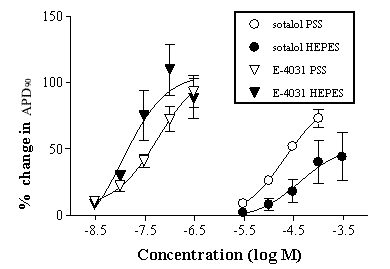| pA2 online © Copyright 2004 The British Pharmacological Society |
090P
University of Bath Summer Meeting July 2004 |
|
Comparison of hepes and H2PO4/HCO3 buffer on canine cardiac action potentials: effects of sotalol and E-403 Nigel P Gillard, Kate A Lansdell and Alison GB Templeton, Quintiles Limited, Research Avenue South, Heriot-Watt University Research Park, Riccarton, Edinburgh EH14 4AP, UK |
|
Studies within our facility investigating the effects of compounds on HERG tail current use a HEPES based buffer. Studies on canine Purkinje fibres use a bicarbonate buffer (PSS). At present separate analytical methods need to be developed to determine the concentration of drug substances exposed to the 2 preparations. This study investigates the use of HEPES buffer in Purkinje fibre experiments.
Intracellular recordings (at 35-36ºC) were made from electrically paced ventricular Purkinje fibres isolated from hearts of Beagle dogs of either sex (4 per treatment group). The fibres were perfused and equilibrated in PSS containing (mM) NaCl 125; KCl 5.4; CaCl2 1.8; MgCl2 1.0; NaH2PO4 1.2; NaHCO 3 25; D-glucose 5.5 gassed with 95% O2:5% CO2, experiments were then either undertaken in PSS or the perfusion was switched to HEPES buffer containing (mM): NaCl 137; KCl 5.4; CaCl2 1.8; MgCl2 1.0; D-glucose 10; HEPES 10. Following equilibration t he effects of dl -sotalol (3-300 µM) and E-4031 (3-300 µM) were compared to vehicle (0.03%-3% v/v reverse osmosis water). Action potential duration at 60% and 90% repolarization (APD60 and APD90), maximum rate of depolarization (MRD), upstroke amplitude (UA) and resting membrane potential (RMP) were measured. Fibres were stimulated at 1 and 0.5 Hz. Changes from pre-treatment for each parameter at each concentration were measured and compared using either Student's t-test (homogeneous) or Mann-Whitney U-test (heterogeneous).

Exposure to HEPES buffer produced a 36% prolongation of APD90 over approximately 10 min, compared to the baseline obtained in PSS (n=12). Both sotalol and E-4031 significantly prolonged the cardiac action potential duration in a concentration - dependent manner in PSS and in HEPES buffer, as expected from these compounds; these effects were inversely frequency- dependent. In the HEPES buffer early after depolarizations were observed following exposure of 3 of the 4 fibres to 300 µM sotalol and 2 of the 4 fibres to 100 nM E-4031. The effects could be due to inefficient intracellular buffering by HEPES, leading to intracellular acidification and subsequent reduction of K+ currents involved in action potential repolarization. These data indicate that, although the spread of data and the efficacy of E-4031 and sotalol appear to be different in the two buffers, HEPES buffer can be used successfully in Purkinje fibre studies.
Fulop et al., Acta Physiol Scand. 2003; 178:11-8